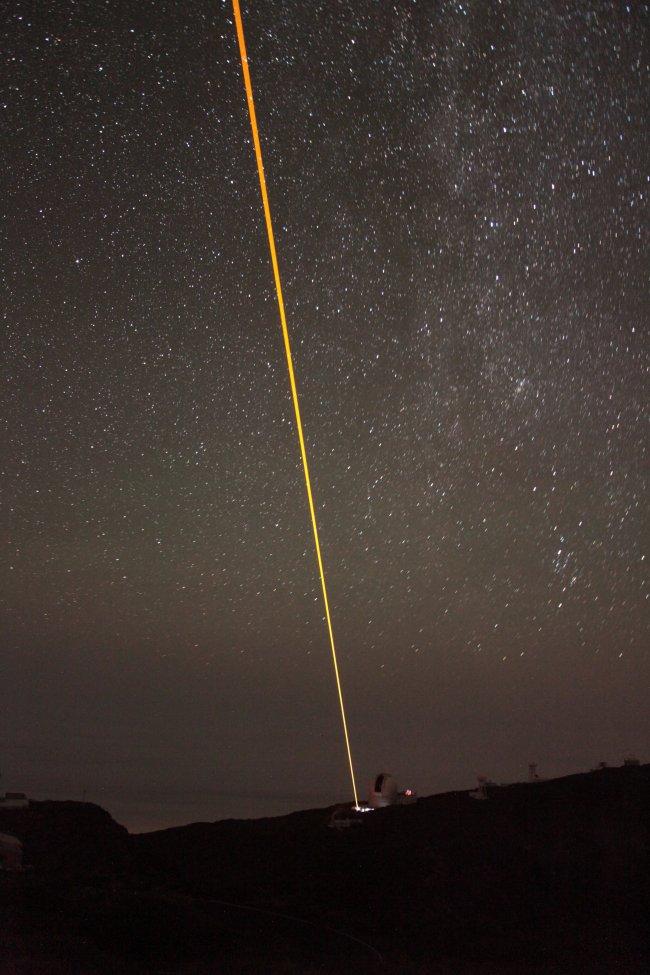An international team of astronomers and engineers from the United Kingdom, France, Italy and Spain, coordinated by Domenico Bonaccini Calia, of the European Southern Observatory (ESO), has successfully initiated from the Roque de los Muchachos Observatory (ORM), La Palma, a programme of measurements to test the viability of a new technique of adaptive optics with laser guide stars. The tests incorporated a transportable sodium laser developed by ESO into the CANARY experimental system of adaptive optics developed by the universities of Durham (UK) and Paris (France) which has been operating for several years on the 4.2 m William Herschel Telescope, of the Isaac Newton Group of Telescopes (ING).
The satisfactory preliminary results, favoured by the quality of the Canary sky, show the high potential of this new generation of adaptive optics systems for very large telescopes, such as the Gran Telescopio CANARIAS (GTC) and future giant telescopes, among them the European Extremely Large Telescope (E-ELT) and the Thirty Meter Telescope (TMT).
The sodium laser, called WLGSU, has a power output of 20 watt and can generate an artificial star at a height of 90 km. From the ORM the CANARY system of adaptive optics used this artificial star to measure the distortions in light produced by atmospheric turbulence and to correct in real time the induced aberrations in astronomical images.
“To simulate the conditions prevalent at the E-ELT the laser was fired from a distance of 39 m from the WHT, a separation which equals the diameter of the mirror of the future E-ELT. At this distance, due to perspective effects, the artificial star acquires an elongated appearance, which makes it difficult to measure. The results obtained at the ORM are contributing to the resolution of this problem and will smooth the path for the instruments under development for extremely large telescopes”, explains Marcos Reyes, an engineer at the Instituto de Astrofísica de Canarias (IAC) who is in charge of the Spanish participation in the project.
“The CANARY instrument “ adds Marc Balcells, Director of the ING, has been for years a Pioneer in the development and innovation of techniques in adaptive optics. On the WHT we proved for the first time the techniques of multi-conjugate adaptive optics, and multi-object adaptive optics, which are essential for giant telescopes. With the incorporation of the sodium laser we hope finally to solve the problem of the elongation of the artificial star”.
Laser guide stars
One of the obstacles to astronomical observation with ground-based telescopes is that the atmosphere distorts the light reaching us from the stars, producing blurred images. To correct this we use adaptive optics technique which allow real time correction of the effects of atmospheric turbulence and obtain images virtually as Sharp as if the telescope were in space. These techniques use very bright reference stars, which allow us to measure the effects of the atmosphere. However these bright stars are widely separated in the sky, and it is rare to find one in an area where we want to observe.
To solve this problem we create artificial stars by projecting high powered lasers into the sky. These illuminate the atoms in the upper layers of the atmosphere and create bright patches which serve as laser guide stars. The higher the layer of this artificial star, the better are the results in correcting the turbulence produced by the different layers in the atmosphere. In recent years sodium lasers have been developed, which emit orange light, which is the wavelength where sodium atoms absorb and re-emit light. These lasers can produce artificial stars at some 90 km above the ground, in a stratospheric layer called the “mesopause”, and this has been a great technical achievement for astrophysics.
At the present time”, comments Begoña García, the Director of the Instrument Division at the IAC, “all the large ground-based telescopes are working on systems of adaptive optics, and laser guide stars. The tests carried out at the ORM are part of an ambitious programme of research and development in this field, involving a collaboration between ESO, the IAC, the Isaac Newton Group of Telescopes (ING), the Gran Telescopio de Canarias (GRANTECAN), the University of Durham, the Paris Observatory, and the Astronomical Observatory of Rome.”
Contacts:
- IAC: Marcos Reyes García-Talavera (mreyes [at] iac.es (mreyes[at]iac[dot]es)), Begoña García (corins [at] iac.es (corins[at]iac[dot]es))
- ING: Marc Balcells (balcells [at] ing.iac.es (balcells[at]ing[dot]iac[dot]es))
- Universidad de Durham: Tim Morris (t.j.morris [at] durham.ac.uk (t[dot]j[dot]morris[at]durham[dot]ac[dot]uk))
- LESIA-Observatorio de Paris: Gerard Rousset (gerard.rousset [at] obspm.fr (gerard[dot]rousset[at]obspm[dot]fr)), Eric Gendron (eric.gendron [at] obspm.fr (eric[dot]gendron[at]obspm[dot]fr))
- INAF-Observatorio Astronómico de Roma: Mauro Centrone (mauro.centrone [at] oa-roma.inaf.it (mauro[dot]centrone[at]oa-roma[dot]inaf[dot]it))
- ESO: Domenico Bonaccini Calia (dbonacci [at] eso.org (dbonacci[at]eso[dot]org))



